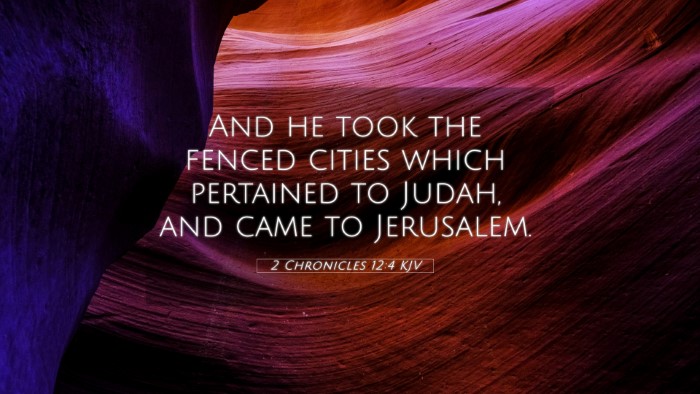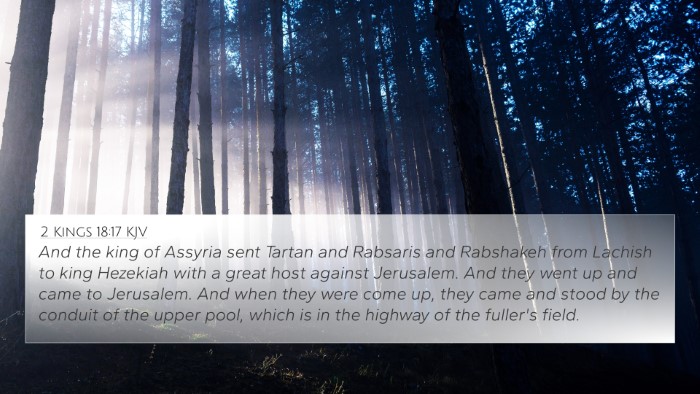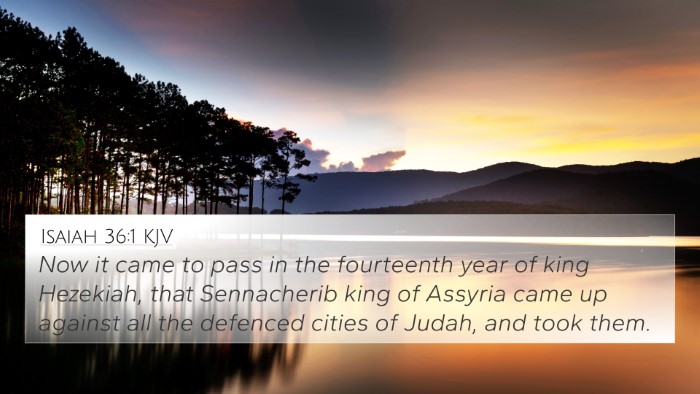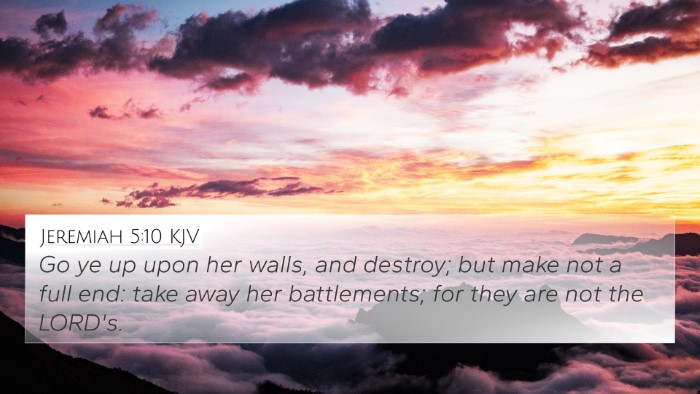Understanding 2 Chronicles 12:4
Bible Verse: 2 Chronicles 12:4 - "And he took the fortified cities which belonged to Judah, and came to Jerusalem."
This verse highlights an important moment in the history of Judah, illustrating the conflict and the geopolitical challenges faced by the kings of Israel and Judah.
Summary of Meaning
The significance of 2 Chronicles 12:4 can be examined through the lens of several influential commentaries.
Insights from Public Domain Commentaries
-
Matthew Henry:
Henry emphasizes the consequences of Rehoboam's decisions and the implications of his leadership. He suggests that the taking of fortified cities indicates the vulnerability caused by turning away from God and the resultant decay in spiritual fortification. This excerpt reflects how spiritual disobedience leads to physical challenges.
-
Albert Barnes:
Barnes notes that Jerusalem was a primary focus for the enemies of Judah and illustrates the historical tensions that arose from the division of Israel. His interpretation suggests that the act of taking cities reflects the aggression of Shishak, the Egyptian pharaoh, and indicates a turning point in Judah's security and stability.
-
Adam Clarke:
Clarke contextualizes this event within the broader narrative of the divided kingdoms. He points to the political and military strategies of Shishak as a significant threat to Jerusalem, underscoring the need for reliance on divine support rather than military might.
Cross-References and Related Verses
Several Bible verses resonate deeply with 2 Chronicles 12:4, revealing broader themes of conflict, leadership, and divine protection:
- 1 Kings 14:26: Highlights the taking of treasures from the temple, paralleling the themes of loss and vulnerability.
- 2 Chronicles 11:5-12: Discusses the fortified cities of Judah, providing background on Rehoboam's defenses.
- Isaiah 36:1-2: Relates to the siege of fortified cities, reflecting ongoing tensions.
- 2 Chronicles 10:16: Chronicles the division of Israel and Judah, emphasizing Rehoboam’s early decision-making.
- Jeremiah 4:5-7: Speaks of preparations for war, akin to the vulnerabilities highlighted in this narrative.
- Psalms 20:7: Expresses trust in divine protection over physical defenses.
- 2 Kings 14:13-14: Discusses conquest and the importance of relying on God in times of strife.
- Lamentations 2:1: A laments reflection on Jerusalem's downfall, echoing the themes of this passage.
- Deuteronomy 28:49-52: Prophecies of foreign nations besieging Israel, relevant to the mentioned adversities.
- Psalm 91:2: Speaks of the Lord as a refuge, which counteracts the vulnerability discussed in this context.
Thematic Connections
The connections between these verses and 2 Chronicles 12:4 illustrate recurring themes of:
- Divine Judgment: The idea that turning away from God leads to external threats.
- Historical Consequences: The impact of Rehoboam's choices on subsequent generations.
- Fortification and Vulnerability: The symbolism of cities as both physical security and spiritual metaphor.
Application in Cross-Referencing Bible Study
Engaging with tools for Bible cross-referencing can enrich understanding of scriptural narratives and their interconnections. Here are some methods:
- Bible Concordance: Utilize a concordance to find themes and related verses.
- Bible Cross-Reference Guide: Guides often provide thematic categorizations that allow for deeper exploration of connections.
- Bible Study Group: Discussing cross-referenced themes can spark new insights and applications.
- Devotional Reading: Incorporating related verses into daily readings can provide a holistic view of Biblical teachings.
Conclusion
The passage in 2 Chronicles 12:4 offers profound insights into the historical and spiritual struggles of Judah under Rehoboam’s reign. By utilizing comprehensive Bible cross-reference materials, one can explore deeper thematic connections and better understand the narrative’s implications within the broader scriptural context.








